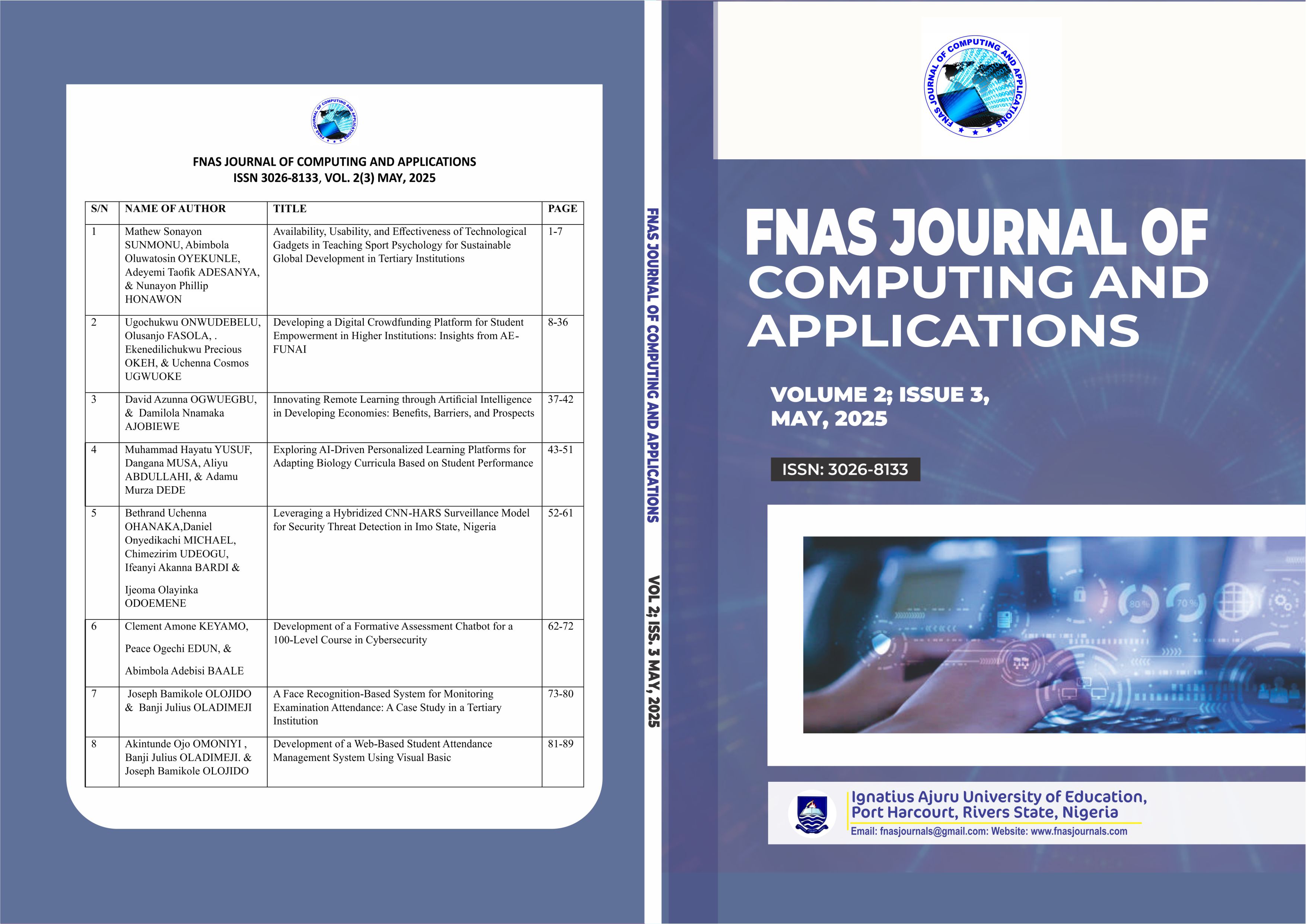Availability, Usability, and Effectiveness of Technological Gadgets in Teaching Sport Psychology for Sustainable Global Development in Tertiary Institutions
DOI:
https://doi.org/10.63561/jca.v2i3.832Abstract
The advent of new technologies in the world has significantly altered the progression of sporting achievements; sports have become increasingly important for recording, analysing and optimising athletic performance. The integration of technological gadgets in teaching sport psychology has become increasingly prevalent in tertiary institutions globally, as those gadgets can provide tailored feedback to help athletes improve their performance. This study aims to explore the availability, usability and efficacy of such tools in facilitating the learning of sport psychology in tertiary institutions in the south west, Nigeria, with a focus on their contributions to sustainable global development. Three (3) research Hypotheses were formulated for this study. Purposive sampling technique was used to select twelve tertiary institutions i.e. two (2) from the six south-west States, while the simple random sampling technique was used to select three (3) teaching staff and twenty (20) students from the department of Human Kinetics and Health Education of the sampled institutions, making a total of two hundred and seventy-six (276) respondents. The researcher adopted a mixed-methods approach, incorporating both quantitative surveys and qualitative interviews; the study examines the perspectives of students and educators in tertiary institutions. Self-structured questionnaire with reliability coefficients of 0.75 was used for data collection. Analysis of Variance (ANOVA) was used to analyse the difference between the variables. Findings revealed that technological gadgets for teaching sport psychology are not available in some tertiary institutions, and that the integration of technological gadgets in teaching sport psychology holds significant promise for sustainable global development in tertiary education. Recommendations were made that the government should provide enough of these gadgets for effective use to teach sports psychology, amongst others.
References
Adeyemi, T., Oluwasegun, S. A., &Alawode, B. A. (2020). Digital competence and teaching
efficacy among tertiary institution teachers in Oyo state, Nigeria. Journal of Education and Practice,11(5), 109-116
Akinpelu, A. O., Agbaje, O. S., &Adegbenjo, O. A. (2021). Technological gadgets as adjuncts in
teaching sport psychology in Nigerian universities: A case study of virtual reality applications. International Journal of Physical Education, Sports and Health, 8(2), 163-170.
Alhumaid, K. (2019). Four ways technology has negatively changed education. Journal of DOI: https://doi.org/10.36941/jesr-2019-0002
Educational and Social Research, 9(4), 10-20. https://doi.org/10.2478/jesr-2019-0049 DOI: https://doi.org/10.2478/jesr-2019-0049
Babalola, S. S., & Bada, T. A. (2019). Effect of interactive whiteboard on the teaching and
learning of sport psychology concepts among university students in Nigeria. Journal of Education and Learning, 8(3), 125-134.
Bamigboye, O. E., Fasakin, O. M., &Olawoyin, O. O. (2020). Technological gadgets as
facilitators of personalized learning in sport psychology education: A case study of tertiary institutions in Lagos State, Nigeria. International Journal of Educational Technology in Higher Education, 17(1), 1-15. Cheung, A. C., &Slavin, R. E. (2013). The effectiveness of educational technology applications for enhancing mathematics achievement in K-12 classrooms: A meta-analysis. Educational Research Review, 9, 88-113. Chiao, H. M., Chen, Y. L., & Huang, W. H. (2018). Examining the usability of an online virtual tour-guiding platform for cultural tourism education. Journal of Hospitality, Leisure, Sport & Tourism Education, 23, 29-38. Fuss, F., Subic, A.,Strangwood, M.& Mehta, R. (2013). Routledge Handbook of Sports Psychology and Engineering. New York. NY. DOI: https://doi.org/10.1016/j.jhlste.2018.05.002
Ibrahim, K. A., & Shittu, L. A. (2018). Assessing the use of technological gadgets in teaching
sport psychology: A case study of selected universities in Nigeria. International Journal of Educational Research and Development, 3(1), 12-20. Iglesias-Pradas, S., Hernández-García, Á.,Chaparro-Peláez, J., & Prieto, J. L. (2021). Emergency remote teaching and students’ academic performance in higher education during the COVID-19 pandemic: A case study. Computers in human behavior, 119, 106713. DOI: https://doi.org/10.1016/j.chb.2021.106713
Johnes, G., & Taylor, J. (2019). The impact of technology on academic performance: A
comparative study of universities. Journal of Educational Technology, 15(3), 45-62. Njoku, C. (2015). Information and communication technologies to raise quality of teaching and learning in higher education institutions. International Journal of Education and Development using ICT, 11(1).
National Universities Commission (NUC). (2019). NUC advocates digitalization of universities
in Nigeria. Retrieved from https://www.nuc.edu.ng/nuc-advocates-digitalization-of-universities-in-nigeria/
Schack, T., Koester, D., Bertolio, M. &Maycock, J. (2014). Technological advancements in
sports psychology. https://www.researchgate.net/publication/263584171.
Schmid, R. F., Bernard, R. M., Borokhovski, E., Tamim, R. M., Abrami, P. C., Surkes, M. A., &
Woods, J. (2014). The effects of technology use in postsecondary education: A meta-analysis of classroom applications. Computers & Education, 72, 271-291. https://doi.org/10.1016/j.compedu.2013.11.002 Semiz, K., &Ince, M. L. (2012). Pre-service physical education teachers' technological pedagogical content knowledge, technology integration self-efficacy and instructional technology outcome expectations. Australasian Journal of Educational Technology, 28(7). DOI: https://doi.org/10.14742/ajet.800
Smith, A., & Jones, R. (2020). Technological inequality in higher education: Public vs. private
institutions. Education and Information Technologies, 25(4), 867-883. Ullah, A., & Anwar, S. (2020). The effective use of information technology and interactive activities to improve learner engagement. Education Sciences, 10(12), 349. DOI: https://doi.org/10.3390/educsci10120349
Wang, Y.,& Li, J. (2022). Bridging the digital divide: Technology availability in tertiary education worldwide. International Journal of Educational Development, 32(5), 101-115.








